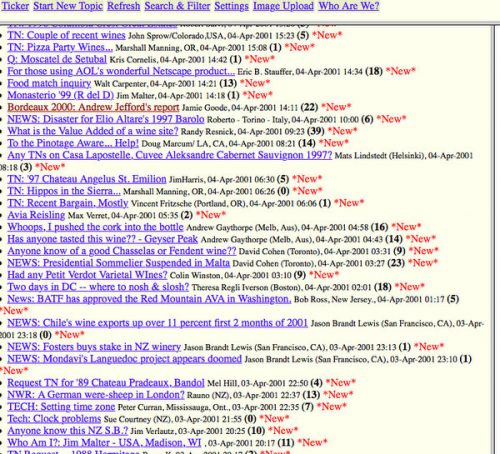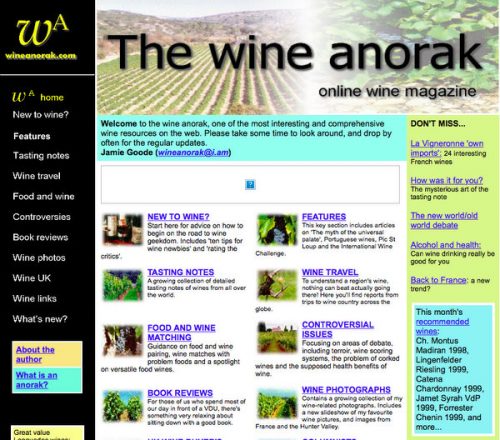
How do people discover wine? What proportion of non-involved consumers end up morphing into involved consumers? And how do people make this transition? These are all very interesting questions. The wine industry needs all sorts of consumers, but if we can understand how people first become wine drinkers, and then how and why a proportion of them become more interested in wine, this could be very helpful.
All I know is my journey. Back when I was at university I didn’t drink wine much. I had come quite late to drinking, taking my first steps at about the age of 17, which by British standards is positively ancient. I had a couple of slightly older friends who I drank beer with after playing tennis or walking in the country, and even at that stage I showed some level of geeky interest in sampling the different kinds of beer. English cask-conditioned ales at the pub were my preferred drink, and I remember being fascinated when I was introduced to Theakston’s Old Peculier, which was a very strong, characterful ale.
At university we drank beer, but occasionally we needed wine for dinner, and then I’d nip down to the local Gateway supermarket and browse the wine aisles. I was bottom feeding, trying to get the cheapest wine that would taste OK. Some of them tasted really bad: this was around 1989, and there were still lots of pretty unpalatable wines around then. Generally, you’d go for the one with the highest alcohol level in your price range.
I do remember the first wine that I tried that I found delicious, as opposed to just palatable. It was a Berri Estates Shiraz Cabernet 1989 (I think, or was it 1986?), and it would have been in the second year of my PhD, which puts it at 1990. The son-in-law of my landlady brought it round for Sunday lunch, and it tasted rich, a little bit sweet, and very smooth. Ah, I thought, there’s something to this wine thing.
Then, after I completed my PhD in 1992 I moved to Wallington in Surrey, and for a while shared a flat with an older friend who’d been to both Oxford and Cambridge, and had been introduced to wine there. He drank modestly but well, and on Sunday evenings he’d often invite a few friends round and open one or two bottles. It was a revelation. I remember trying a Pouilly-Fuissé that actually had real personality, and this hooked me onto the flavour of good Chardonnay. I also remember being introduced to Claret: a 1982 Léoville-Barton did the trick. But the wine that impressed me the most was the 1991 Brokenwood Graveyard Shiraz, which became the first wine I purchased more than one bottle of (three, at £13.49 each).
Two of my friends at the time, Michael and Jason, were also quite taken with wine, and we began buying and drinking bottles together. Michael had a copy of Parker’s Wine Buyers’ Guide. This was one of the early editions, and we began to look out for high scoring wines in our price range. I loved the enthusiasm Parker showed in his write-ups: here was a fellow enthusiast. A happy place was finding his 86 As – wines scoring 86, which was then a good score (before score inflation, maybe the equivalent of today’s 90), but in the cheapest price bracket. We had quite new-world palates at the time, favouring wines with lots of flavour impact, but one quirky discovery that we enjoyed was Château Musar, which at the time was inexpensive. We drank quite a few bottles of Musar. But, in general, we were disappointed with the wines that we bought from supermarkets. They had the same names as the wines we’d tried with our friend, but not the same flavours. I recall that another buying guide that came in useful was the Sunday Times guide authored by Robert Joseph, based on results from the International Wine Challenge, which was in its infancy then.
I had quite a bit of luck at the local specialist wine shop, called The Wine House. Operated by Morvin and Sue Rodker, the wines here were a bit more expensive than supermarket versions, but they tasted good. I was at the stage in my drinking career where I’d try something that I really loved, but I couldn’t say exactly why I liked it, and I then struggled to replicate the experience. Evidently, I had a latent geeky interest, but it took people like my friend, and the nearby presence of a decent wine shop, to lure me in properly. They gave excellent recommendations. I remember them talking me up to a Chablis Grand Cru once, telling me: ‘Live a little!’
What else do I remember from the early days? Oddbins was in its prime in the early 1990s, and the eclectic selection on the shelves of this specialist chain was ideal fodder for a newbie geek. They sold the wines well, too, with enthusiastic staff and excellent wine lists. I also remember finding good bottles in the high-end specialist selection in the local Asda and Waitrose supermarkets. At the time, both stocked some interesting bottles. And then there were branches of Thresher and Wine Rack, with a few goodies in their selection.
Fine wine was cheaper then. This made the odd foray into the classics affordable. I spent most of my time, though, exploring the new world, and Australia was my first love. Indeed, my first visit to vineyards was back in 1996, when I went to Melbourne with work. I hit the Barossa Valley, and Fiona and I stayed cheaply in a caravan as we toured round Victoria. Our first ever winery visit was at Charles Melton in March 1996. Australia was interesting back then, and the likes of St Hallett, Rockfords and Penfolds drew me in with their ripe but complex wines. Penfolds’ Grange was still selling at £35 in the UK in those days, before it was hiked massively along with the rest of the previously good value Bin range.
I also remember my first encounters with Brettanomyces, although it the time I didn’t know what it was. A friend brought round a supermarket Crozes Hermitage, and I found the farmyard aromas and strongly savoury taste very off-putting. I also found the same flavours in a Richeaume wine from Provence.
I also began going to consumer tastings, which were quite memorable because at the time we didn’t know how to spit, so they started well and ended a bit blurry. I began to write down my impressions of the wines, taking the first stage of developing a wine vocabulary.
So, by 1996 I was a proper wine geek, still very early on in my journey but anxious to explore. And explore I did. Along came the internet, so I started a hobby wine site on Geocities, which a couple of years later became wineanorak.com. The actual website I have now was started in November 1999, so it’s one of the oldest out there. I started blogging in September 2001, so mine is now the oldest extant wine blog (the one or two that preceded it are no longer there). I learned a great deal from being a participant in the Wine Lovers’ Discussion Group. In the late 1990s this US-based bulletin board was the place to be for discussing wine online, and there was a golden period when professionals and amateurs alike shared their knowledge. It was at the right sort of scale for it to work, and very good spiritied. It didn’t last too long, but for me as a keen newbie it was a superb place to make connections and learn.

It was in 2002 that I started earning money for writing about wine, as well as picking up advertising income from my growing website (I’d had adverts from 2000). In 2004 I got a book deal; in 2005 I got a national newspaper column; and in 2008, already in possession of a couple of Glenfiddich Awards, I quit my day job to work full time with wine.
So, is this typical of wine geeks? Are there lots of people out there like me, with a latent interest in wine that just needed triggering? Or do people just get sucked into it, irrespective of any latent interest? It would be interesting to know whether there are strategies to get people interested in wine that would work with many people. Or is it just a few who potentially could go on to become serious wine drinkers? It may well be that some people are more curious generally about flavour, and that they will find their way. But it could also be that some people are put off because the only wines they get to experience are uninteresting, and so they are never more than uninvolved consumers who view wine as just a commodity. That would be a shame.
3 Comments on My journey into wine
Another fine article Jamie. I started even later than you being mainly a beer drinker till in my late twenties. My journey into a love of fine wine,really started when I had to entertain for business reasons . When someone else is paying for the wine you drink,you tend to trade up!! The wine that really did it for me was a bottle of Yarra Yering Dry Red number 1. Still a favourite .
Thanks as always for your blog which has for me always been the best out there.
Great article JG. If you search the old articles you can probably still find a few of my early pieces written on South African wines in around 2000 as your “South African Wine Correspondent”!! You didn’t travel there every day back then! How time flies. But it’s been a fun journey!
I got into wine in the early nineties when I was 20. My trigger was a blind tasting at university. Having someone tell you the basics – where to hold a wine glass, why one swirls it, how to properly “nose” it, etc. demystified quite a bit of the unknown side of wine for me. It gives you a little confidence in dealing with the subject. We were also handed a list of “cultivar characteristics”, which noted typical characteristics in terms of appearance, aroma and taste found in the most prevalent South African varietal wines of that time. I was fascinated! To make the mind shift to actually recognise the myriad of non-grapey things to be found inside a wine glass, was a game changer. I think to demystify (but beware of dumbing down) wine while also allowing exposure to its complexities (but beware of pretence and snobbism), is key to luring people into wine beyond the commodity level.